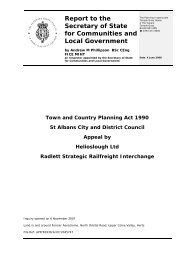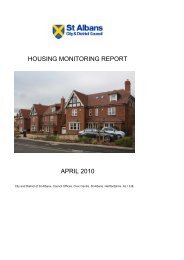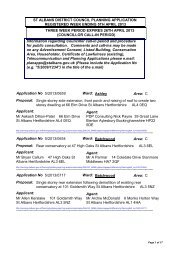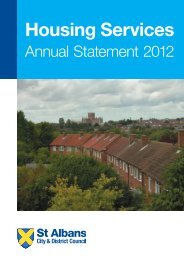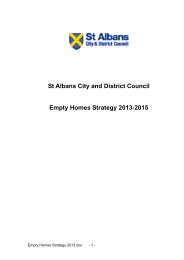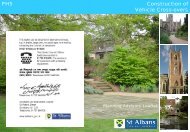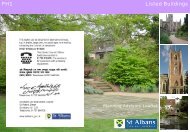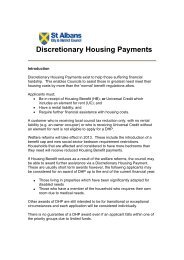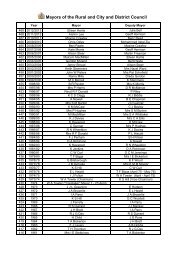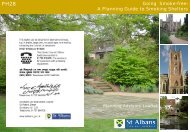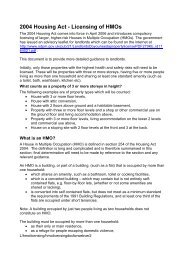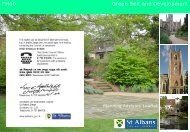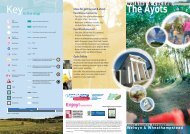14 October 2011 - St Albans City & District Council
14 October 2011 - St Albans City & District Council
14 October 2011 - St Albans City & District Council
Create successful ePaper yourself
Turn your PDF publications into a flip-book with our unique Google optimized e-Paper software.
New Matters and Changes in Circumstances: Rail Freight<br />
6 East Midlands Route Utilisation <strong>St</strong>rategy<br />
6.1 The Executive Summary of the East Midlands RUS quotes the following on Page 7:<br />
“Analysis has demonstrated that the current provision of generally two off-peak<br />
daytime freight paths per hour on the MML, at current utilisation levels of 60<br />
percent, is sufficient to accommodate the forecast growth in the short term. A<br />
third path per hour has been demonstrated as not being achievable within the<br />
constraints of the current infrastructure”.<br />
“The RUS recommends that two off-peak daytime paths in each direction (the<br />
southbound path being 60mph and 2000 tonnes trailing load) are preserved south<br />
of Bedford within the Thameslink Programme development timetable”.<br />
6.2 Also in para 4.5.2 the RUS explains:<br />
“The aggregates market is a major contributor to rail freight in the RUS area,<br />
with four major quarries in the area at Croft, Bardon Hill, <strong>St</strong>ud Farm and<br />
Mountsorrel that serve London and the south east markets using a number of<br />
terminals on the MML, in the London area and elsewhere. There is also aggregates<br />
traffic from the Peak Forest area. The Freight RUS expected construction traffic<br />
to grow by 20 percent in tonnes lifted over the period, and approximately 25<br />
percent in train numbers”.<br />
6.3 A 25% increase in freight train numbers would increase the current utilisation of<br />
the existing two freight paths per hour off peak on the MML from 60% to 75%.<br />
6.4 Section 5.4.3 sets out the freight capability of the routes within the East Midlands<br />
RUS area and states:<br />
“The constraints associated with the availability of freight paths on the MML are<br />
highlighted in Chapter 3. Analysis has demonstrated that the current provision of<br />
generally two off-peak daytime freight paths per hour in each direction on the<br />
MML, with most northbound services having light weight trailing loads, and with<br />
current utilisation levels of 60 percent, is sufficient to accommodate the forecast<br />
growth in freight traffic that needs to operate on this section of the route. There<br />
is limited ability to serve multiple destinations from these paths. The RUS<br />
assessment of freight capacity south of Bedford also concluded that there is a<br />
potential conflict between the operation of additional Thameslink off-peak<br />
services north of Cricklewood and the need to accommodate freight trains. This<br />
conclusion will need to be tested as part of the timetable development work led<br />
by the Thameslink Programme.”<br />
6.5 It is clear from the above that the existing two freight paths per hour past the<br />
Radlett site are well used and are likely to be more fully utilised in the future due<br />
to the growth of aggregates traffic. Appendix D to this report shows the current<br />
freight trains per day on the MML. The existing two freight paths per hour off-peak<br />
past the Radlett site will be retained and are compatible with the future<br />
Thameslink services, but a third freight path per hour has been demonstrated as<br />
not being achievable. Also, there is a potential conflict between the future<br />
Thameslink off-peak services and freight trains which is acknowledged by Network<br />
Rail as needing to be tested as part of the timetable development work being led<br />
by Thameslink.<br />
5



